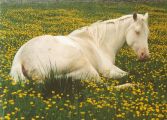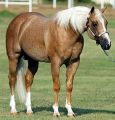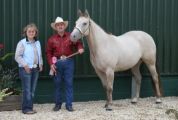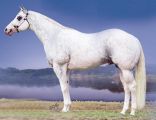Search The Horse Genetics Website (opens in a new tab)
Quarter Horse Colors
A discussion of quarter horse colors - real and registrable.
Until recently there were just 13 accepted quarter horse colors recognized by the American Quarter Horse Association, even though horses of pure-bred quarter horse origin actually occurred in other colors. Those accepted quarter horses colors were sorrel, chestnut, bay, black, brown, gray dun, red dun, grullo, buckskin, palomino, red roan and blue roan. An interesting mix that was decided when little was known about horse genetics!
The predominant quarter horse colors are reported to be sorrel and chestnut (according to their frequency among registered horses). It is interesting that these two colors are listed separately since sorrel horses are actually light chestnut. The use of two terms sometimes creates confusion. I’ve heard the term sorrel used interchangeably with chestnut, with people describing darker chestnut horses as sorrel. In some countries, such as the UK, many horsey people haven’t even have heard of the term sorrel in connection with horses!
Dun, red dun and grullo are distinguished as separate quarter horse colors, although they are all caused by the dun factor gene. Red dun is usually reserved for duns with a chestnut (or sorrel!) base coat, while grullo is the term for a dun with a black base coat. Presumably dun is used for any other combination, notably those with bay or brown base coats.
Buckskins and palominos are horses with a single copy of the cream gene. The first have either bay or brown base coats, but smoky blacks were also registered as buckskins. Palominos have a chestnut (or sorrel!) base coat. Until recently double cream dilutes weren't registrable as pure-bred quarter horses, even if their parents were both 100% quarter horses of 100% foundation breeding!
The double dilutes include cremellos, perlino, and smoky cream which are now accepted quarter horse colors (hooray!).
New dilution genes are now being recognised. The champagne colors occur naturally among quarter horses, with their hazel or greenish eyes and their freckles. Some of these are registered as palomino, or as other cream dilutes, although more and more people recognise the champagne colors as being separate from the cream colors.
The silver dapple (or Taffy) gene does occur very rarely in quarter horses and I predict it will increase in frequency as people become interested in this lovely new (quarter horse) color. Probably there are more American Quarter horses with the silver gene than is currently realised, with some horses being mis-identified, either genuinely or for registration purposes! Also since the gene barely shows itself on red horses there may also be unidentified carriers too.
AQHA set forth strict rules regarding white markings, which should be limited on the face and below the knees. This was despite the fact that foals born of pure-bred parents frequently broke the rule!
Even now the registration certificates of such horses must bear the words: "This horse has white markings designated under AQHA rules as an undesirable trait and uncharacteristic of the breed”. But for one or two alleles in about 60,000 (0.0017-0.0033%) these horses are the same as any other quarter horses and may well have a more ideal conformation and temperament than some solid quarter horses. The money invested to produce them is usually high and their owners are rightly proud them - regardless of their “excessive” white – and they want to show and breed from them.
It seems rather sad that Quarter Horse breeders who get “spotless paint horses”, and paint breeders who get solid foals, have to feel their otherwise quality horses are considered “second class” or unwelcome by some members of both AQHA and the APHA. (And I’m not speaking here as a disgruntled breeder, just as an observer of a peculiar, artificial, and – in my opinion silly – situation!). Another consequence of selecting for minimal white markings is that it occassionally results in foals with the fatal lethal white overo syndrome. The overo spotting pattern is phenotypically heterogeneous and minimally marked horses may show insufficient pattern to be identified as overo horses, even though they have the overo genotype. The AQHA rule will undoubtedly have caused selection for minimally marked overo horses.
Unsurprisingly there are cases of quarter horses having sired or produced lethal white foals, even though they don’t obviously carry the overo gene (i.e. because they have minimal patterning). Not so long ago a somewhat worried lady emailed me alerting me to such a problem. Her stallion – who is without noticeable overo body spotting patterns - had nevertheless been shown to have the overo gene (by molecular testing). Unfortunately he’d already been bred to a couple of mares who also have overo. One only hopes she had a good outcome.
It is clear that quarter horse colors aren't set forever in stone. As more is known so the AQHA rules on quarter horse colors (eventually) change. And when it comes to actual quarter horses, they don't always seem to read the rules. They may well have ideas other than those of the AQHA authorities.







